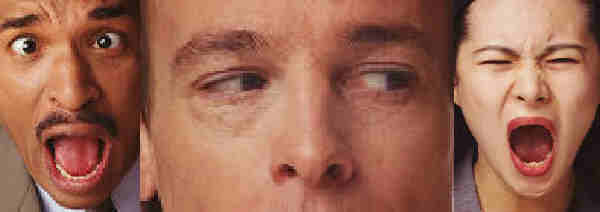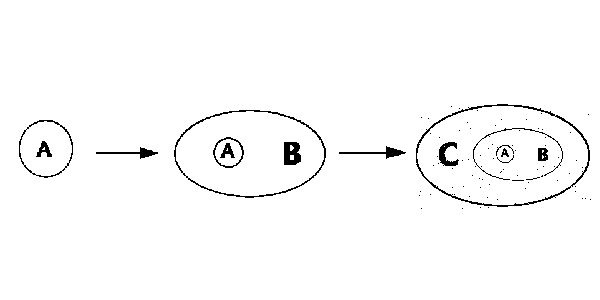
All material on this page ©2003 by 21st Century Education, Inc
Doylic Memory
An Essay by Bobby Matherne, ©2001
Copyright ©2000by 21st Century Education, Inc.
Site Map: MAIN / This Page

An Essay by Bobby Matherne, ©2001
Copyright ©2000by 21st Century Education, Inc.
How is it possible for some event to trigger a doyle? In computers, we have a concept known as associative memory, whereby the address of a storage element is a portion of the thing that is contained in the storage element. From what we know about human memory, our brains work the same way. We think of some event in our past, some small part of it, and if we concentrate, we will be able to retrieve more and more of the event, an associative memory feat. Doyles work the same way. Take the following two doyles A and B (note that the sizes and shapes of the doyles have no meaning, the oval or the circle is purely arbitrary, a line that merely circumscribes some area which we name by the letter it encloses.) Thus, A and B below represent two doyles that may or may not be related or associated with each other.
If all of doyle A is contained in doyle B then the appearance of doyle A causes doyle B to be evoked or to arise in the person. This can be diagramed as follows:
Figure 1.
Now consider A to be sensory data impinging on a person, sensory data that is contained inside of doyle B as shown above. The effect will be that A will act as a trigger to evoke doyle B, that is, by associative memory, sensory data A will act as an associative address to fetch doyle B from memory storage and thus cause it to arise in the person.
In a general diagrammatic form, we have shown how doyle triggering occurs and how a linkage of doyles occurs. If you consider the possibility of doyle B being contained within doyle C, then a linkage to doyle C will occur, and you have a cascade of doyles from trigger A to doyle B to doyle C.

Even though A is shown as a localized section of B, the process of A triggering B is one of completion of a pattern, that is, A is really a diffuse pattern in B that B coalesces around through a process of hologram completion. This is shown diagrammatically in the next figure. A exists as components of B, C, and D doyles, but selects the strongest of the three doyles, which is B. This figure explains why A triggers B and not C, for example, because A is not a strong enough component of C by itself, A cannot trigger C directly, but only after A triggers B, then and only then B is able to trigger C.
Now, what is it that happens during a speed trace? Let's say that the person doing the trace is 40 years old. At age 40 the A sensory inputs trigger doyle B as shown below. The doylic memory that we have labeled B, which includes all of the trigger inputs A, sends out signals from doylic memory (1) which may do any of the following: adjust muscle tension, adjust homeostatic settings of internal organs, change respiration rate, change heart rate, and cause all sorts of other sensations that we call by the generic term feelings. A doyle has been triggered and is holding the person right now. B is generated from the only memory storage that was available when B was stored, doylic memory.
Figure 2. Doyle at Age 40
Let's represent the situation in the right side of Figure 2 as follows: ((A) B ) Now suppose the person has a doyle present at age 40 and thinks, "I'm age 30, and I'm experiencing this doyle." Let's diagram that situation as: ((30) 40) where A = 30 and B = 40. What is happening? The person is 40 and experiencing a doyle and goes to the place in his neocortex where what happened to him at 30 is stored. Since there is no cognitive memory (2) of the doyle B at age 30 either, the same doyle must arise from doylic memory. (3)
Next the person, continuing the speed trace, says "I'm age 20, and I'm experiencing this doyle." That can be represented as (((20) 30) 40) and again the same doyle arises from doylic memory. This process continues down to five years old and can be represented as:
(((((5) 10) 20) 30) 40)
At each time mark going down from 40, 30, 20, 10, 5 the same doyle arises from doylic memory. Let's assume that for this man the doyle was originally stored at age two and a half. The trace continues to 3 and the doyle arises at each lower time mark from doylic memory when he says the following, "I'm age 4, am I'm experiencing this doyle?" so he answers, "Yes" and continues to the next one. "I'm age 3, am I'm experiencing this doyle?" and the answer is also yes. This can be diagramed thus:
(((((3) 4) 5) 10) 20) 30) 40)
At next time mark he says, "I'm age 2, am I'm experiencing this doyle?" and he notices that the doyle is no longer present -- it's gone, disappeared from his body -- the bodily states that he had called "this doyle" have somehow dissipated. At this point he has led himself through the labyrinth of his memory to a place, to a time when the doyle did not exist, so the doyle cannot arise from his doylic memory. There is no doylic memory stored at:
((((((2) 3) 4) 5) 10) 20) 30) 40)
In addition, for the very first time in his life he has visited this place, this time in his memory with cognitive memory capability! By hypothesis, when he was 2, he had no cognitive memory. (4) Now, at age 40, doing the speed trace, he has cognitive memory, and when he jumps from 3 to 2, over the original event at 2.5, a record is made of the doyle (B) in cognitive memory for later use.
This recording is the same process that happens whenever any event happens to us after five years old: we make a cognitive memory of it. The cognitive memory of B contains the trigger stimuli of (A) and all the non-doylic components (5) of (2.5), that is the events at two and a half to the individual. These events may be retrieved at this point by his asking himself the following question, "What's a plausible thing that could have happened to me at two years old that could have given me the doyle I had?" At this point, his cognitive memory, having just seconds before stored the cognitive memory of the original event will flash his before his mind, so he should pay exquisite attention to what thoughts pop into his mind while and after asking the plausibility question. Those thoughts will provide anything from a shadowy clue to a direct, vivid memory of the original event. The information can then be checked with parents or older siblings or caregivers that might be able to corroborate the information.
Remember this MOST IMPORTANT function of the Plausibility Question or PQ:
You get CONFIRMATION of a SUCCESSFUL TRACE immediately!No need to wait 2 or 3 weeks to find out if the doyle returns. You know immediately that a speed trace has worked because a speed trace transforms a doylic bodily memory into a COGNITIVE memory, and getting plausible explanation for the original event demonstrates immediately that you have done just that: COGNIZED a DOYLE!
What happens the next time that trigger stimuli (A) impinges on this man? The cognitive memory of (2.5) stored during the speed trace will arise in his mind. He may remember the original event vividly or the shadowy image or perhaps only the memory of his doing the speed trace. What exactly happens inside the person as to the memory is completely idiosyncratic, but what happens as far as doyles arising, it is the same for everyone: no doyle (B) arise from (A), only the person's individual, non-doylic, cognitive memory arises. The doyle (B) that the person wanted to be rid of is completely gone.
If a man whistling in the dark caused the woman to feel intense terror spasms with increased respiration and rapid heart pulse rate before the speed trace, afterward she'll merely note, "Oh, that's a man whistling outside." with no change of internal state similar to the previous terror state. If a scorpion caused intense fear when one appeared in the house, after the speed trace, she'll note the scorpion and either sweep it outside or call a terminator to get rid of it, all without fear states as formerly. If a man clutched the armrests of his airplane seat in terror the first time the plane dips in mid-air, he will be able to enjoy a long nap through the bumpiest rides from now on. If a man got seasick when he went fishing offshore, he will be able to fish in as much comfort as the next fisherman during rolling seas without the least discomfort.
This is how a speed trace works, but it has one big limitation - it won't work unless you apply it in your life. Learn to do a speed trace on something simple like a food dislike and then apply it to other areas to improve the quality of your life. It may take a long time to read all the information, to practice and accomplish your first speed trace, but after the first one or two traces, you'll learn what we veteran tracers like to say about doyles - if you're not sure this bad feeling or tension or illness you have is a doyle or not, "When in doubt, trace it out!"
to be continued . . .
~^~^~^~^~^~^~^~^~^~ footnotes ~^~^~^~^~^~^~^~^~^~^~^
1. Postulated to be the amygdala in the limbic system of the brain. Return to text.
2. Postulated to be the neocortex of the brain. Return to text.
3. By definition of a doyle, there can be no cognitive memory of a doyle, since doyles are stored and arise only from doylic memory not cognitive memory. Return to text.
4. A basic hypothesis of doyletics is that the neocortex cannot store cognitive memories on a permanent basis until five years old. Return to text.
5. By hypothesis, cognitive memories cannot contain doylic components or physical body states. Return to text.
Copyright ©2001 by 21st Century Education, Inc.
~^~ Relief is just a Trace Away! ^~^~
Faces of People who have Traced Away Unwanted Doyles! 
